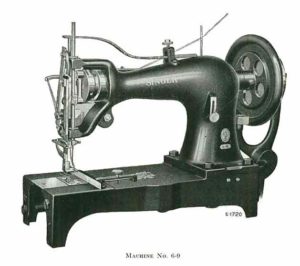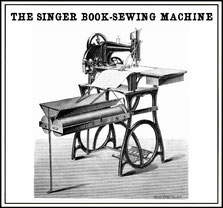Singer Book-Sewing Machine, Model 6-9, American ca. 1911
 The lockstitch sewing machine, invented by Elias Howe in 1849 (1), was not the first machine intended for sewing, but it was the machine upon which subsequent sewing machines were based. Intended to attach two flat surfaces together, the sewing machine revolutionized the making of clothes, shoes, umbrellas, flags–virtually anything that had formerly been hand-sewn. One exception: sewing traditional multi-signature books, which require stitching through signatures while attaching those signatures to each other. It would not be until David McConnell Smyth produced the Smyth No. 3 that book-sewing on an industrial scale became possible. The process is still known as “Smyth-sewing.”
The lockstitch sewing machine, invented by Elias Howe in 1849 (1), was not the first machine intended for sewing, but it was the machine upon which subsequent sewing machines were based. Intended to attach two flat surfaces together, the sewing machine revolutionized the making of clothes, shoes, umbrellas, flags–virtually anything that had formerly been hand-sewn. One exception: sewing traditional multi-signature books, which require stitching through signatures while attaching those signatures to each other. It would not be until David McConnell Smyth produced the Smyth No. 3 that book-sewing on an industrial scale became possible. The process is still known as “Smyth-sewing.”
 But not all books were Smyth-sewn. Lockstitch sewing machines were used to saddle stitch more ephemeral products such as cheap paper-covered books, pamphlets, and composition books. ABM’s Singer Model 6-9, ca. 1911, meant for industrial use, was purpose-built and advertised specifically for sewing through paper–as much as 3/4 of an inch (2). The machine could be operated by foot treadle or–later–by electric motor.
But not all books were Smyth-sewn. Lockstitch sewing machines were used to saddle stitch more ephemeral products such as cheap paper-covered books, pamphlets, and composition books. ABM’s Singer Model 6-9, ca. 1911, meant for industrial use, was purpose-built and advertised specifically for sewing through paper–as much as 3/4 of an inch (2). The machine could be operated by foot treadle or–later–by electric motor.
 Singer advertised an accessory folder that attached to the sewing table. A folded signature was sewn in the machine then slid into a hopper where it was folded by dropping through two rollers. In a stationery bindery paper might be ruled for notebooks, trimmed, gathered into 40- or 50- sheet stacks and stitched down the center, folded and finally glued into a cover. The books that resulted were less sturdy than traditionally made books, but were meant to be written in, and were likely both more ephemeral and cheaper.
Singer advertised an accessory folder that attached to the sewing table. A folded signature was sewn in the machine then slid into a hopper where it was folded by dropping through two rollers. In a stationery bindery paper might be ruled for notebooks, trimmed, gathered into 40- or 50- sheet stacks and stitched down the center, folded and finally glued into a cover. The books that resulted were less sturdy than traditionally made books, but were meant to be written in, and were likely both more ephemeral and cheaper.
__________
1 https://historycambridge.org/innovation/Sewing%20Machine.html
2 https://www.fiddlebase.com/book-sewing-machines/

